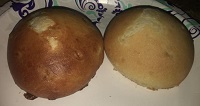Baking
home >> baking
2022
February
Schoko Crossies

Figure 1: Schoko Crossies
Für den kleinen Hunger zwischendurch. :)
Quarktorte
Genau wie bei Muttern. :)

Figure 2: Quarktorte
Brötchen mit und ohne Ei bestrichen
Schmecken beide sehr gut.

Figure 3: Käsebrötchen
Käsebrötchen
Eins mit normalem amerikanischen shredded Taco cheees, eins mit dünnen Scheiben Gruyère Käse. Das zweite schmeckte nicht so gut.

Figure 4: Käsebrötchen
January
And another Käsebrötchen
Bisher hab ich mich an denen noch nicht sattgegessen. Aber zehn Brötchen pro Tag ist ja auch nicht so viel. Diesmal mit Mehl von ALDI. Geht genausogut, schmeckt genausogut.

Figure 5: Käsebrötchen
Again Käsebrötchen
Endlich! Wirklich ausgezeichnete Käsebrötchen. Ich war etwas großzügiger mit dem sourdough starter und habe etwas weniger Ruhezeit gegeben. Und dann hab ich nur Löcher in den geformten Brötchenteig gestochen, keine Striche gezogen. Jedes Brötchen wiegt 90g. Die sind super aufgegangen.
- 330g water
- 500g King Arthur unbleached all purpose flour
- Knead in the baking machine. I did it for about 5 minutes.
- Spray with water
- Rest for about 1 hour
- Add salt, 4g instant yeast, ~100g sour dough starter
- Knead again for about 6 minutes
- Spray with water
- Rest for another hour
- Heat the oven to 230°C or 446°F or 416°F in the convection oven. I have a convection oven.
- Cut 90g pieces of the dough, fold into a round roll and roll them round on the table
- Place them fairly wide apart on the baking tray. I had to use two trays for 4 rolls each
- Spray with water
- Place a good handful of shredded cheese on each roll
- Put the trays in the oven and
- Throw about half a cup of water on the bottom of the oven
- Bake 10 Minutes
- Enjoy

Figure 6: Käsebrötchen
Fruchttorte
2 Tüten gefrorene Pfirsich und Erdbeeren

Figure 7: Fruchttorte
Again Käsebrötchen
Better than last time, but still kind of flat

Figure 8: Käsebrötchen
Käsebrötchen
Normales Brötchenrezept, und dann die Brötchen direkt vor dem Backen mit Taco Cheese bestreut. War lecker.

Figure 9: Käsebrötchen
Brötchen
Die ersten richtig guten Brötchen, die ich gebacken habe.

Figure 10: Brötchen
Quarktorte
I didn't let it cool off in the oven, so it broke up a little. Tasted just fine.1

Figure 11: Quarktorte
Fruchttorte
I used 1 kg of mixed frozen fruit. I didn't lay them out early enough, so there was still too much water in the fruit. It didn't hinder the taste, but it took much longer to cool because the thickened fruit juice had to cool down.

Figure 12: Fruchttorte
Marmorkuchen
I didn't have a bunt cake form so I baked it in a round cake form. It looked great from the inside and out. I have ordered a bunt cake form for the next time.

Figure 13: Marmorkuchen
Baguettes
I want to make Brötchen, but there are no good recipes anywhere that result in that fluffy airy dough, at least none of those recipes have worked for me. Baguettes have a similar dough, so I am starting here and then I will go smaller. :) They came out allright, not professional quality, but very nice for me. The recipes below are so much more complicated than anything I have tried before, and it paid off.

Figure 14: Baguettes
First time I am using sourdough starter from the recipe of Eric Kayser. His videos on how to make bread and how to make baguettes are fantastic. Way more complicated than any bread baking recipe I have seen in any book, but it is so helpful. He is by far the best teacher of baking skills I have seen.
Recipes
Baguettes
Mis en place
- Tools
- stand mixer
- thermometer to take the dough's temperature
- dough scraper
- dough cutter
- bread lame
- water
- pastry brush
- Ingredients
- 500g of classic bread flour (I'm using King Arthur's® bread flour
= 100g liquid sour dough starter
- 330 g water
- 9g coarse salt
- 4g fresh active baker's yeast
Process
Including the resting periods this will take a minimum of 4.5 hours
- Initial dough autolyse2
Igredients:
- 330g water
- 500g flour
Pour the water first into the mixing bowl, then the flour. Sir together. Cover up with baking cloth (kitchen towel) and rest for 1 hour.
The tamperature of the water must be according to the baker's formula:
Tair °C + Tflour °C + Twater °C = 70°C
In my case all three have pretty much identical temperatures.
- Adding sourdough, yeast and salt
- 100g sourdough starter
- 4g active baker's yeast
- 9g salt
Put the salt on one side of the bowel and the yeast on the other. Then pour the liquid sourdough starter into the bowl. First mix the dough (on stage 1) then knead the dough (on stage 2-3) for 6-7 minutes.
Put in on the baker's towel and measure the temperature of the dough with a food thermometer. Stick it into the middle. The temperature of the dough must be 23°C - 24°C. This is tricky for me because I am already starting with all ingredients on that temperature.
Cover with a baker's cloth. Rest for 1 hour.
- Cut into 3 pieces
Cut into 3 equal pieces. Form them into round pieces by folding the edges together. Rest for another 30 minutes.
- Last resting
Lightly flour the work surface. Slightly press the round loaf. Roll out the loaf and fold it 3 times. Roll it into baguettes. Place it on the baker's cloth with the seems on top. Cover the dough and leave it to proof for another 2 hours.
- Bake the baguette
Score the baguettes with three slashes of the lame. Place them in the oven with the seem on the bottom.
Bake at 240° for 20 to 23 minutes.
Sourdough starter
Day 1
- 20g rye flour
- 20g filtered water (chlorine is bad for yeast)
- 5g honey
Rest covered at room temperature for 24 hours.
Day 2
- 40g rye flour
- 40g water
- 5g honey
Rest covered at room temperature for 24 hours.
Day 3
- 80g rye flour
- 80g water
- 5g honey
Rest covered at room temperature for 24 hours.
Day 4
- 80g rye flour
- 58g water
Rest covered at room temperature for 24 hour and it's ready for use.
This can be stored in the fridge for up to 72 hours, but refresh. e.g. if you have 200g of sourdough starter add 200g of wheat flour and 200 g of water.
For bread use 10% - 20% of the weight of the flour.
If the starter is not working ad 5g, 10g, or 20g honey to the starter.
Log
2022
February
========
Tue Feb 01 14:56:45 Central Standard Time 2022
I have tried many different ways to bake the rolls, and it seems like nothing can go wrong anymore. That's a bit weird considering how long it took me to get it right. I came up with a number of reasons:
- I beat the heck out of the dough now, for 6-7 minutes on a high setting that my kitchenaid would be dancing across the kitchen if I diddn't held it down.
- My starter dough is getting more mature and seems to do its job much better
- I always wait for 1 hour to let the autolyse process maximize.
- The most important proofing time is after I shaped the rolls. That's pretty forgiving as well. It shouldn't be more than 2 hours though.
- Flour doesn't matter. Cheap flour is as good as expensive flour.
- Water doesn't matter. I use tap water, and it works just fine, even though it contains chlorine.
January
========
Mon Jan 24 09:36:10 Central Standard Time 2022
Die normalen Brötchen habe ich mit Taco cheese bestreut. War lecker.
========
Mon Jan 17 16:04:46 Central Standard Time 2022
Gekauftes Brot is ja ziemlich lange haltbar, auch die Brötchen. Selbstgebackenes Brot muss sofort gegessen werden. Meins auf jeden Fall. Einen Tag später schmeckt es schon nicht mehr.
========
Sun Jan 16 13:39:40 Central Standard Time 2022
Das Krustenbrot ist superlecker. Eigentlich mag ich die Kruste am Brötchen ja auch am liebsten.
========
Sun Jan 16 12:51:37 Central Standard Time 2022
Another attempt with baguette and Brötchen. It rises allright, but then it falls again. I think I might have to trz to cut the last rising down from 2 hours to less. I'm also going to try 80g of sourdough instead ot 100g. I'm looking at them baking in the oven, and the color is nice. They will be crunchy, but the form is terrible.
========
Sat Jan 15 19:26:22 Central Standard Time 2022
Waiting for another 2 hours for the bread to proof. I am baking bad :). I'm breaking the rules. The dough should proof now with the seem side up, and then it would be placed on the baking stone. I don't have such a large baking stone, so I use the form, and I fitted the dough already into the form. I also oiled the form and sprayed oil onto the dough. Now I only need to to score the bread. I hope I don't forget it like last time.
========
Sat Jan 15 18:26:00 Central Standard Time 2022
I had forgotten that my oven had a breadproof setting. :) That's where my loaf is right now, proofing for 1 hour.
After I had kneaded the dough for 5 minutes I had taken the temperature: 21.9°C. Not enough. The dough must be between 23°C - 24°C. I added a minute. Still not enough. Another two minutes later finally 23.1°C! In fact that was one minute longer than the recommended max 7 minutes, but I guess baking has to be adjusted to the current environment.
========
Sat Jan 15 17:40:56 Central Standard Time 2022
Crap. I forgot to measure the temperature of the water when I mixed it with the flour for the autolyse. Well, I'm too far in. I can do it better tomorrow. I also got the Brötchenform today. Instead of 250°C for the Baguette I will heat the oven to 230°C. I can't wait! :)
Footnotes:
This is just how my mother always made it.
Raymond Calvel is the inventor of the modern method of autolysis. According to the King Arthur Baking Company® "French scientist and bread expert Prof. Raymond Calvel developed this technique in 1974, in response to what he saw as a deterioration in French bread production."